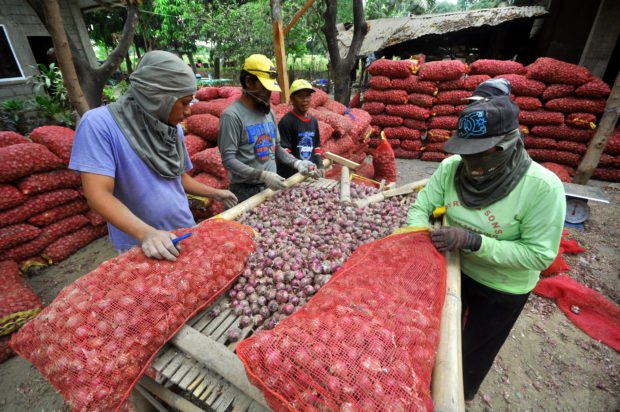Farmers wary of gov’t plan to import onions

BULB SORTING Onion traders in Bayambang, Pangasinan, sort newly harvested bulbs before these are delivered to a local market. In the nearby province of Nueva Ecija, where onion is a major cash crop, growers appeal to the government to stabilize onion prices for the benefit of consumers and farmers.—WILLIE LOMIBAO
BONGABON, Nueva Ecija, Philippines — With the government’s plan to import 35,000 metric tons of red onions by mid-February to plug local production gap, farmers here expressed fear that this would further cut farm-gate prices and leave them with no profit.
Leon Abunan, 72, a farmer in Barangay Lusok here, said he was hoping that the importation of bulbs, whether red creoles or yellow granex, would not happen during the harvest season in March.
Agriculture Secretary William Dar had approved the importation of red onions to “plug the two-month production gap in the country.”
“These red onions can only be brought in up until mid-February so that it will not be in competition with the main harvest time starting March,” Dar said.
Data from the Philippine Statistics Authority showed that the price of red onion reached P195 a kilogram for wholesale last month.
Article continues after this advertisement‘Crushing blow’
Abunan said the government should review its importation plan as this would cause a “crushing blow” to local onion farmers and producers. He said he had wanted to give up onion farming, which he started when he was 20, because of rising production cost and declining profit.
Article continues after this advertisement“My siblings had stopped planting onions and resorted to tomato farming [for better profit],” he said, adding that he would spend about P150,000 to plant onions in his farm.
With the impending onion importation, he might not recover his capital, Abunan said.
Too high
Mayor Allan Gamilla said the P130 to P200 a kilo prevailing price of onions was “too high for consumers.”
“But the government must exhaust all means to control the price before considering importation,” he said.
Gamilla said harvest in his town would start by second week of February, almost the same time imported onions, if the importation pushed through, would flood the market.
Like Abunan, Gamilla said a price of P40 per kilo of bulbs would be “enough for local farmers to make a little profit.”“The government can stabilize the price of onions as it can dictate the right price that will be both beneficial for the consumers and the farmers. There should be a balance,” he said.
Records from the municipal agriculture office showed over 2,300 hectares of farmland here were planted to onions in 2019.
Free seeds, pesticides
As of this month, out of 1,376.84 ha, 970.19 ha are planted to red creole, 405.55 ha to yellow granex and 1.10 ha to red shallot. Gamilla said the Department of Agriculture (DA) had extended support for farmers by distributing free seeds and pesticides. But he feared these would go to naught if onion prices would dip during harvest time.
Gamilla said onion importation during the harvest season would also deny local farmers of cold storage when needed.
“It’s OK to import but this should not be done during harvest time to allow farmers to recover their capital and make some profit,” he said.